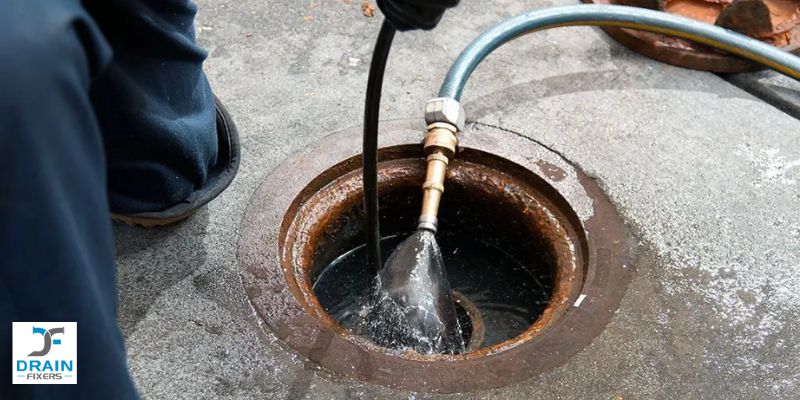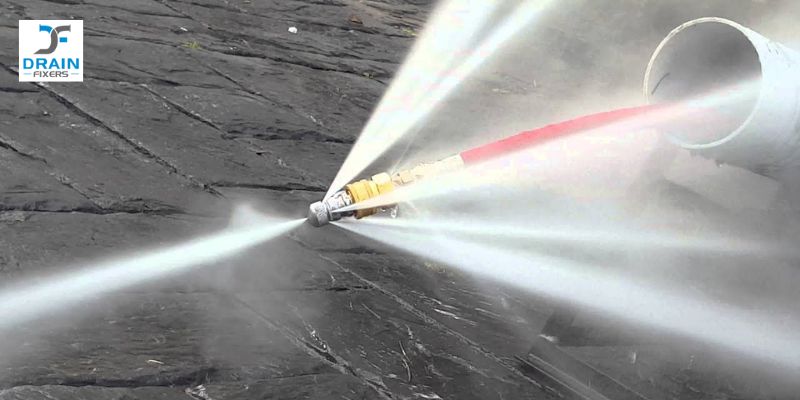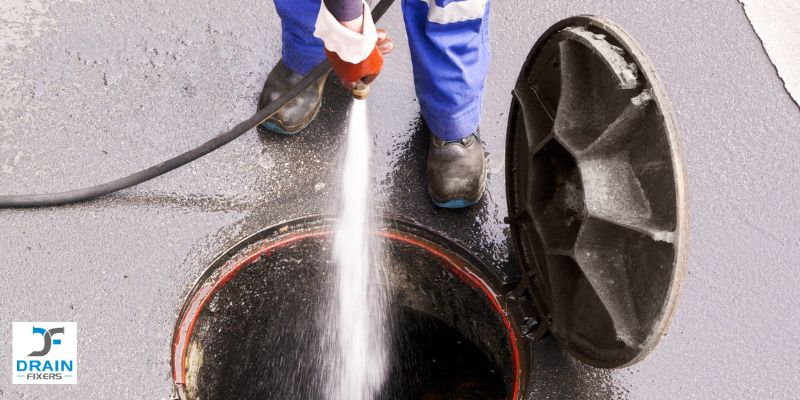
Hydro jetting is one of the most common techniques drain specialists use for drain cleaning in the fall and spring seasons. Hydro jetting can assist in forcing fluid out of drains. If dirt or debris is clogging your pipe, downspouts, or sewer line and preventing water flow, hydro jetting can help by ejecting it with pressure. Hydro jetting techniques for drain cleaning are environmentally safe and cost-effective. Here is what you should know about this drain-cleaning method:
What is hydro-jetting?

As its name suggests, hydro jetting sends water down a drainage system under high pressure to clear out clogs. Hydro jetting works by using a cleanout, a tiny opening or a drain that leads a drain-fixing plumber to faulty locations in the drainage system. Hydro jetting does not require excavation.
After a drain specialist locates the pipe, a pliable hose with a tapered head is introduced into the drain line. The professional also inserts a hydro-jetting machine at the other pipe end. The attached hydro jetting equipment is fitted with a huge water tank with high pressure. The hose or tube can deliver water pressure ranging from 3,000 to 5000 psi and thoroughly clean the pipe, whether domestic or commercial drainage.
Drain-cleaning plumbers use the line at high pressure to eject water. The drain pipes move vigorously as they respond to water pressure. The pressure washes down any residual material it meets inside the pipeline, and the force of the water breaks the blockages apart by flushing them down the drain.
Some drain cleaning technicians use CCTV drain cameras or sonar, technological devices that help locate underground issues. Any of these devices can trace clogged drain problems to an accurate location. And view the video to find out the source of the clog. Depending on the site and type of drain clog, a drain cleaner inserts a nozzle head during hydro jetting.
How do you know you need hydro-jetting service?
Several things might contribute to your need for hydro jetting service. Regarding your drainage system, it would be best if you understood that your pipes, sewers, downspouts, and drains could accumulate dirt to the point where they block entirely. Hydro jetting service is the best way to solve all your clogged drain problems as it helps clear out the main pipeline, storm drains, clogged downspouts, water pipes, and sewer pipes. It also helps fix the septic system. Hydro jet nozzles help clear tree branches, rocks, mud, and sand.
If you have just acquired a property, it is best to hire a drain cleaning specialist to inspect the drainage system for underground clogs before you start living there. Using hydro jetting techniques in a new home can help you avoid future problems and costly drainage system repairs. Also, proper drainage maintenance at your business or home can help maintain a clog-free drainage system.
Why should you use hydro jetting for drain cleaning?
If you are considering using other drain cleaning techniques other than hydro jetting, you might not come up with a better solution. Hydro-jetting is the best method for removing sludge from your drainage system. Your drain specialist only uses forceful water pressure to clear the drain pipes. You cannot compare the hydro-jetting technique with a sewer snake technique, which uses rotating metals that can cause the pipe to break. A snake works by spinning through blockages but cannot solve the main problem that caused the pipeline blockage. Indeed, the snake cable can clear the pipe, but a jetter sweeps it clean.
Hydro-jetting is also more economical since it only focuses on clog removal. However, property owners who use this drain-cleaning technique will maintain a clean drainage line for an extended period. After removing accumulated dirt from your drain pipes, it will take a long time for your pipeline to build up pipe-blocking dirt.
How do you use hydro jetting?

1. Employ a professional to conduct sewer line inspections
It would be best to use hydro jetting without checking your drainage system. Your professional drain cleaning plumber will first use a CCTV drain camera or other drain-detecting devices to check your drains for clogged areas or broken pipelines before suggesting hydro jetting. Suppose the damage is severe enough that the pipe is completely clogged. In that case, your drain specialist will need to implement mechanical rooting to bring back water flow, which will help increase the exposure of the pipeline on camera.
2. Power jetting the pipe
After a thorough inspection by the drain cleaning specialist, the next step is to implement pressure jetting. Your drain specialist will connect a tube and a cleaning nozzle head, allowing over 7,000 PSI to approximately 60,000 PSI water pressure in the pipe. Drain cleaners change the nozzle head depending on the problem location. Serious clogs, such as tree branches and gunk or grease buildup, can be easily removed using hydro jetting methods.
3. Further inspection
Many professional drain cleaners will ensure quality work by re-inspecting the drainage system using CCTV drain cameras. This is to ensure that all clogs have been cleared out and there are no residuals in the pipeline. It also helps to know if the drain pipes can still function at their best.
The hydro-jetting cleaning technique helps in two ways:
#1 Forceful flushing and the breaking up of residual materials stop the proper water flow. Hydro jetting is powerful enough to clean out the toughest clogs.
#2 Hydro jetting uses pressure to wash the drainage walls and clean through their diameters without causing damage to the drain lines.
Conclusion
Hydro jetting is one of the best drain-cleaning techniques for residential and commercial underground drainage systems. It is safe, quick, and less messy, and you can have a clean drainage system for an extended period before clog problems arise again in the future. If your building is facing clogged drain problems, hire a local drain cleaner and get your comfort back.

